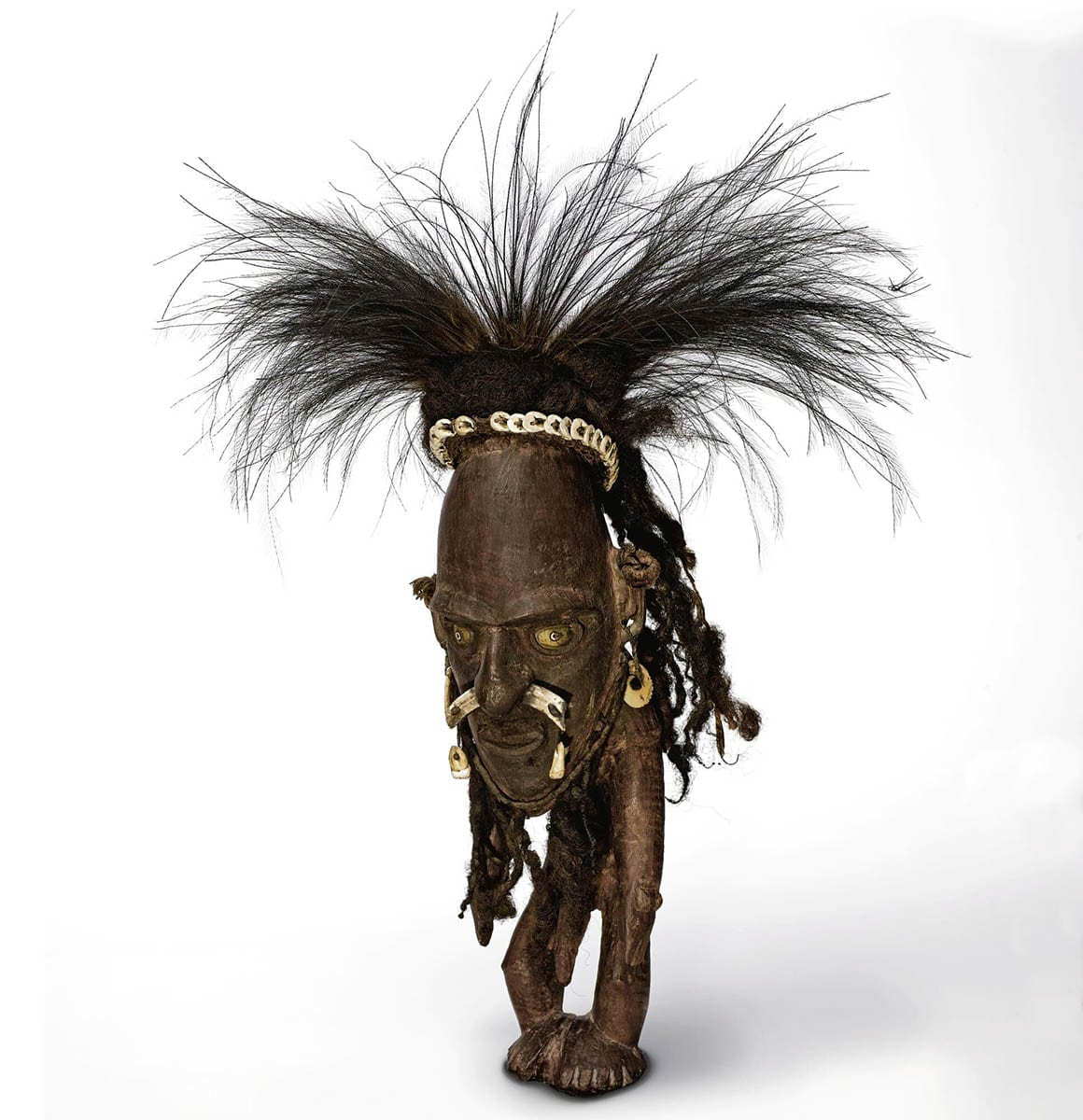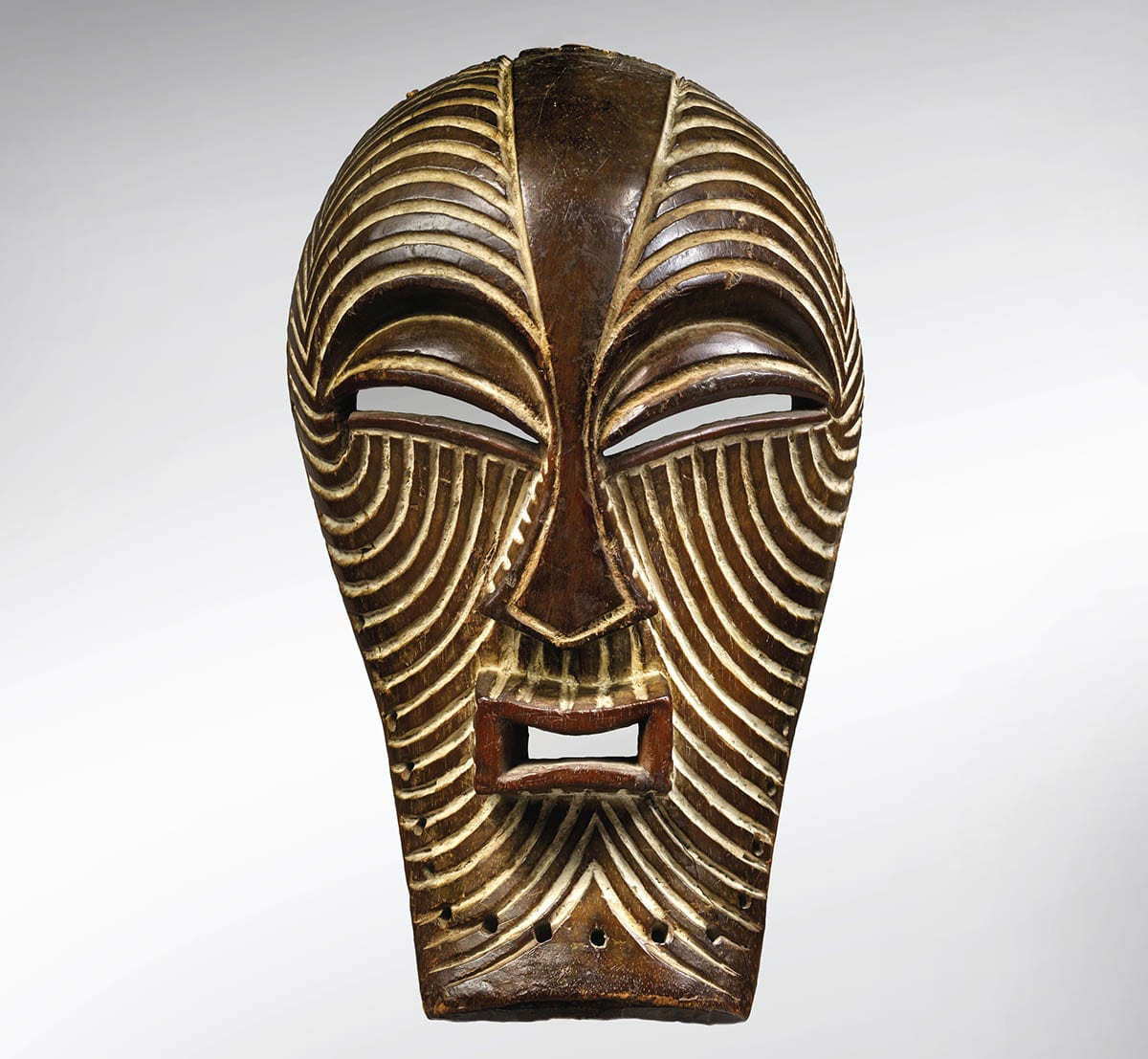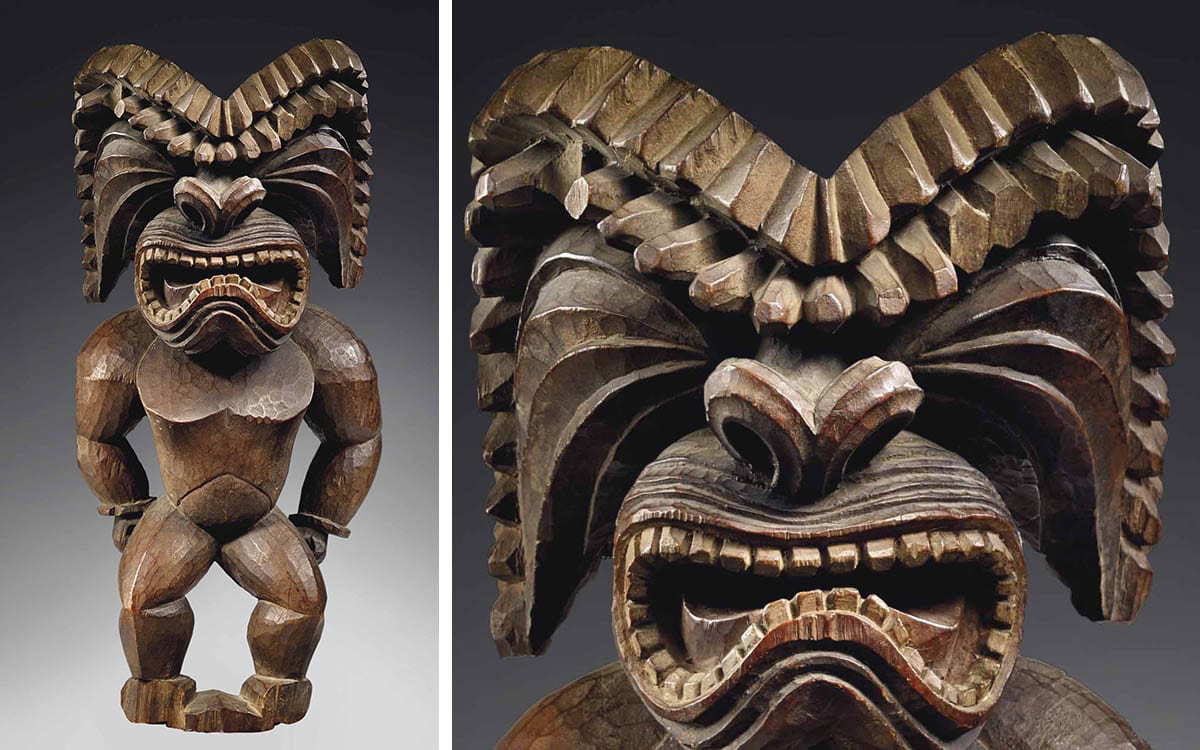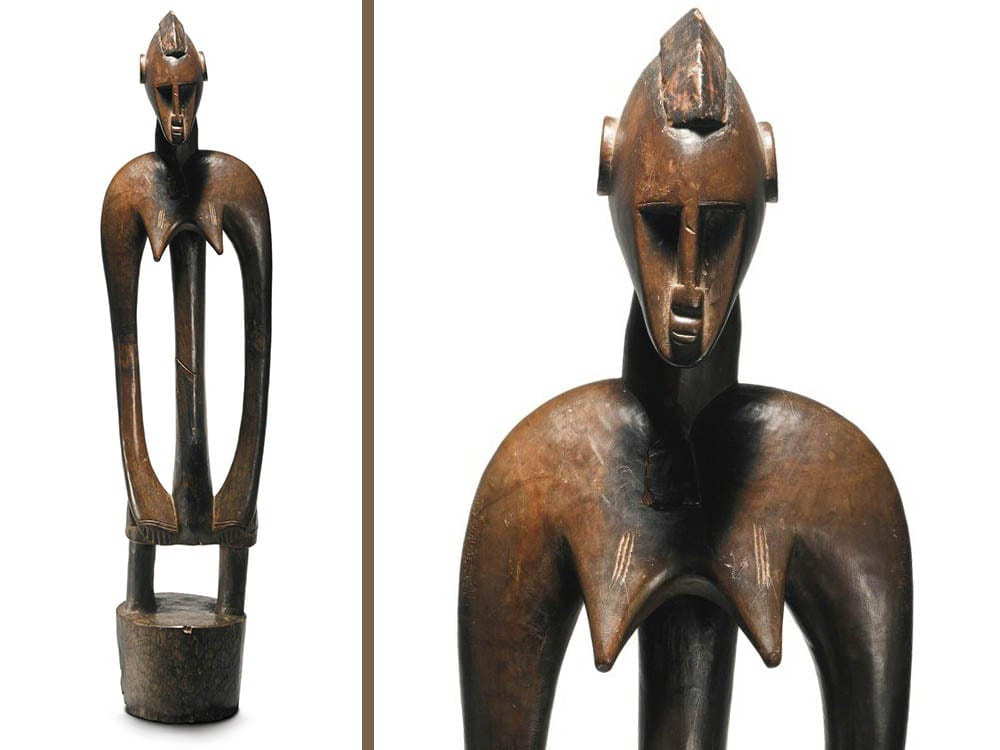In African Art Such as That of the Senufo People Spirit Figures Are Often Shown as

In the 1960s, both Sotheby'due south and Christie'southward opened upwardly new departments specializing in fine art from the previously disregarded continents of Africa and Oceania. Pieces of art from beyond Sub-Saharan Africa, Commonwealth of australia, Melanesia, Micronesia, Polynesia and Indonesia became more attainable than e'er to collectors, many of whom proved willing to office with incredible sums of money in exchange for a tribal sculpture, ritual mask or bequeathed figure. Some of the most exceptional purchases of Oceanic and African fine art have been in the past decade, with vii-effigy auction results (and even one eight-effigy!) appearing regularly.
Read on to discover the ten near expensive auction results in African and Oceanic art from the concluding x years.
Auction Results: Oceanic And African Art
The art made by the peoples of sub-Saharan Africa, the Pacific Islands and Australia differs greatly from western art. While the artists of Europe were decorated with oil paints, watercolors and etchings, the craftsmen of the southern hemisphere were far more concerned with decorative and ceremonial objects, such every bit masks, figures and abstract sculptures. These were ofttimes fabricated from precious materials, including gilt, and were laden with symbolism. Not just exercise they concord aesthetic value in and of themselves, but they also provide important insight into the behavior, lifestyles and techniques of the indigenous peoples who fabricated them. The following ten pieces of fine art embody the diverseness of styles, methods and designs that originated across Africa and Oceania during the previous centuries. They also yielded the highest auction results.
10. Biwat Male person Ancestor Spirit Figure From A Sacred Flute, Wusear, Papua New Guinea

Realized Cost: USD ii,098,000
Estimate: USD 1,000,000-i,500,000
Venue & Engagement: Sotheby's, New York, 14 May 2010, Lot 89
Known Seller: New York art collectors, John and Marcia Friede
About The Artwork
Inhabiting the shores of the Sepik River in Papua New Guinea, the Biwat people believed in a powerful crocodile spirit, known as asin. They created striking effigies of these spirits called wusears, which were placed on the stop of long bamboo flutes and were thought to contain the spiritual auras of the asin. When the flutes were blown, the mystical sound that emanated from the wusear was considered the voice of the spirit. These wusear were considered so valuable in the Biwat community that a man was justified in kidnapping a adult female to be his bride, then long as he offered her family 1 of the sacred flutes.
Are y'all enjoying this article?
Sign up to our Gratuitous Weekly Newsletter
Please bank check your inbox to activate your subscription
Cheers!
This mask, which sold at Sotheby'southward in 2010 for just over $2m, was discovered by a German language expedition in 1886, and then passed through the hands of numerous European and American collectors. Alongside the forest, shell, pearl oysters and cassowary feathers that make up the terrifying outline of the spirit'due south face, it is adorned with real human hair and teeth!
9. Lega Iv-Headed Effigy, Sakimatwematwe, Autonomous Republic of the congo

Realized Price: USD 2,210,500
Estimate: USD 30,000-50,000
Venue & Date: Sotheby's, New York, 14 May 2010, Lot 137
Known Seller: Bearding American collector
Almost The Artwork
Like the wusear of the Biwat peoples of Papua New Guinea, the sakimatwematwe made by the Congolese Lega tribe played an important role in initiation ceremonies. In detail, it was used to initiate men into the Bwami society, which dictated their conduct and taught life-lessons through aphorisms. These aphorisms were represented by the sakimatwematwe.
The present example, for case, shows four heads, distinct from one another and yet inseparable joined by the elephant leg on which they all stand. Information technology was known by the catchy title of "Mr. Many-Heads who has seen an elephant on the other side of the large river". It is thought to represent how a unmarried hunter cannot kill an elephant lone but arrives on other members of his tribe. This hitting wooden statue with its four elongated faces is therefore an item of significant spiritual importance, matched only by its fabric value subsequently it was sold at Sotheby'due south in 2010 for $2.2m.
8. A Fang Mask, Gabon

Realized Price: EUR two,407,5000
Venue & Engagement: Christie'south, Paris, 30 Oct 2018, Lot 98
Known Seller: Collectors of African art, Jacques and Denise Schwob
About The Artwork
Like the Bwami lodge of the Lega peoples, the Fang tribes of Gabonese republic, Cameroon and Guinea had their own sects, sub-groups and brotherhoods. Among these was the Ngil, a community of men who took information technology upon themselves to enact acts of justice under the encompass of both night and masks. Masks played a key office in Fang guild: the more elaborate the mask, the greater i's condition and rank in the social hierarchy. In keeping with their retributive mission, the Ngil wore some of the near intimidating masks of all.
This rare example of a Ngil-style mask stands at 60cm, the elongated face designed to frighten people who might be harboring evil intentions. Such masks are incredibly rare, with roughly 12 known examples left. It is, therefore, no wonder that they accept historically had huge sale results, with the present case selling at Christie'south in 2018 for €two.4m.
seven. Muminia Mask, Lega, Democratic Republic of the congo

Realized Price: EUR 3,569,500
Gauge: EUR 200,000-300,000
Venue & Appointment: Sotheby'southward, Paris, 10 December 2014, Lot vii
Known Seller: Belgian collector of Congolese art, Alexis Bonew
Most The Artwork
The Bwami society, who were responsible for the entrancing iv-headed sakimatwematwe, also had masks (muminia) as office of their ritual ceremonies and group activities. Interestingly, these alpine wooden effigies were rarely worn on the torso: although sometimes worn atop the caput, they were more than often affixed to the wall or fence of a temple or shrine. They were made not to disguise the wearer, simply to impress the other initiates in the society with the size, scale or design of his muminia. The mask maketh the homo.
In 1933, however, the Europeans who then ruled Congo made the Bwami society illegal, and the product of such objects seems to have died out. Consequently, the present case is ane of merely three traditional Bwami masks known to exist today. Too equally signifying some of the unintended consequences of colonization, this also adds to its material value, as shown when it was sold at Sotheby's in 2014 for over €three.5m – ten times its estimated auction result!
6. Fang Reliquary Effigy, Gabon

Realized Price: EUR 3,793,500
Estimate: EUR ii,000,000 – 3,000,000
Venue & Date: Christie's, Paris, 03 Dec 2015, Lot 76
About The Artwork
This Gabonese figure was originally owned by Paul Guillaume, a Parisian art dealer who was responsible for popularizing tribal with some of the first African art exhibitions in the city. By introducing this new world of fine art to the French capital, Guillaume indirectly influenced some of the important advanced artists of the twentieth century, such as Picasso. European artists and intellectuals were particularly fascinated with the art of the Fang peoples of Equatorial Africa.
Amid the numerous genres of Fang art were byeri, or ancestor sculptures, fabricated in the epitome of ane's ancestors and used to telephone call upon their spirit in times of need. Information technology is thought that these statues may even take been attached to the boxes holding the remains of the very ancestor depicted! The nowadays instance has the remarkable addition of bronze rings to represent the pupils, besides as a hole on the crown of the head to allow for the insertion of feathers. It certainly caught the middle of collectors when it appeared at Christie'due south in 2015, with the sale consequence reaching almost €3.8m.
5. Ngbaka Statue Of The Mythical Ancestor Seto, Democratic Commonwealth Of Congo

Realized Price: USD 4,085,000
Estimate: USD i,200,000 – 1,800,000
Venue & Date: Sotheby's, New York, xi Nov 2014, Lot 119
Known Seller: American collector of African art, Myron Kunin
About The Artwork
With an impressive provenance including eminent African art collectors, Georges de Miré, Charles Ratton, Chaim Gross and Myron Kunin, this statue is widely considered one of the finest masterpieces of Ubangi art. The Ubangi region spans modern-day Sudan, the Democratic republic of the congo and the Central African Republic, incorporating a collection of societies with potent cultural ties.
Two of the bulwarks of this culture were belief in spirits and the importance of sculpture. Together these went hand-in-hand to produce some incredible pieces of art, such as this effigy of Seto. Seto was believed to be ane of the earliest mythical ancestors, among those who created the universe, and he played an of import role in fables as a trickster. He would take had his own shrine in Ubangi villages, where statues and figures of him would have been used in worship rites and ceremonies. With its cultural history and pedigree provenance, it is no wonder that the statue realized a massive price at in 2014, yielding an sale event over twice its estimate at $4m.
4. The Walschot-Schoffel Kifwebe Mask

Realized Price: USD 4,215,000
Venue & Date: Christie'due south, New York, fourteen May 2019, Lot 8
Known Seller: Collector of African art, Alain Schoffel
Well-nigh The Artwork
Estimated to have been made in the nineteenth century, the Walschot-Schoffel Kifwebe mask became a office of a major European collection in a affair of decades following its manufacture. Jeanne Walschot, a champion of African fine art, displayed information technology at the Cercle Artistique et Litteraire in Brussels in 1933, where it attracted the attention of some of the almost important French intellects of the 24-hour interval.
Originating in Congo, the mask is loaded with meaning. The white stripes may accept been designed to symbolize purity, wisdom, dazzler and goodness, but alternative theories suggest that they represent the zebra, which, despite not inhabiting the Songye territory, had gained mythical status through the tales exchanged between tribes. The pattern is at once simple and yet slightly hypnotic, its beauty making it one of the most valuable pieces of African art sold in the last decade, having been won at Christie's in 2019 for over $iv.2m.
three. Fang Mabea Statue, Early 19th Century, Cameroon

Realized Toll: EUR 4,353,000
Estimate: EUR 2,500,000 – 3,500,000
Venue & Engagement: Sotheby'southward, Paris, eighteen June 2014, Lot 36
Known Seller: The family unit of art collector Robert T. Wall
Virtually The Artwork
Previously owned by Felix Fénéon and Jacques Kerchache, two spearheads of the African fine art market, this statue is 1 of around a dozen figures left made by the Fang Mabea tribe of Cameroon. Over one-half a meter in pinnacle, it represents one of the ancestors worshipped and revered in their civilization. With its crisp detail and smooth carving, the statue embodies some of the finest craftsmanship in African art, which is why i anonymous bidder was willing to office with the immense sum of €four.3m to add together it to their collection when it appeared at Sotheby'south in 2014.
2. Hawaiian Figure, Kona mode, Representing The God Of War, Ku Ka 'Ili Moku, Circa 1780-1820

Realized Price: EUR 6,345,000
Venue & Date: Christie'south, Paris, 21 November 2018, Lot 153
Known Seller: Native fine art collectors, Claude and Jeanine Vérité
Known Buyer: Tech developer and businessman, Marc Benioff
About The Artwork
This intimidating statue was made when King Kamehameha I was uniting the Hawaiian Islands in the early twentieth century. Like endless rulers throughout history, Kamehameha sought to legitimate and strengthen his rule past associating himself with a deity, in this example, the Hawaiian god of war, Ku Ka 'ili Moku. Therefore, either on his orders or to win his favor, priests beyond the islands began to create figures of Ku Ka '2 Moku bearing the likeness of the king.
When information technology appeared in Europe in the 1940s, the statue was immediately snapped up past renowned fine art dealer Pierre Vérité, who kept it as one of his most prized possessions until his death, when it passed on to his son Claude. In 2018, when it was bought at Christie'due south for over €half-dozen.3m by tech billionaire Marc Benioff. Benioff made headlines by donating the figure to a museum in Honolulu, feeling that it belonged in its native state.
i. Senufo Female Statue, Deble, Ivory coast Or Burkina Faso

Realized Price: USD 12,037,000
Venue & Engagement: Sotheby's, New York, 11 November 2014, Lot 48
Known Seller: American collector of African art, Myron Kunin
About The Artwork
One of simply five known figures of its kind, this Senufo female statue is exceedingly rare. Its intriguing abstract design, which appears to defy gravity, the wave likes forms and protruding abdomen that symbolize pregnancy, and the ground-breaking use of open space all contribute to this figure's status every bit one of the finest pieces of African art e'er produced. One of the most remarkable things most it is that its creator can be identified: the Primary of Sikasso was an anonymous artist active in Burkina Faso from the nineteenth to the twentieth centuries.
The statue besides has an impressive provenance, having passed through the hands of influential African fine art collectors such as William Rubin, Armand Arman and Myron Kunin, equally part of whose manor it appeared at Sotheby'south in 2014. There, it was sold at the incredible price of $12m, breaking all sale results records for an African statue, and demonstrating that native art has become a major player on the world market.
More than on Auction Results
These ten pieces of art represent some of the finest sculptures, masks and figures to appear in the African and Oceanic art departments of the major auction houses. Over the past decade, new scholarship and research into native fine art and civilization has brought with it a new appreciation for the genre. As a result, millions of dollars accept been spent by fine art dealers, enthusiasts and institutions, all eager to add such a masterpiece to their collection. Click here for more than impressive sale results from the concluding five years in Modernistic Art, Quondam Primary Paintings and Fine Fine art Photography.
Source: https://www.thecollector.com/top-10-african-oceanic-art-sold-in-the-last-decade/
0 Response to "In African Art Such as That of the Senufo People Spirit Figures Are Often Shown as"
Post a Comment